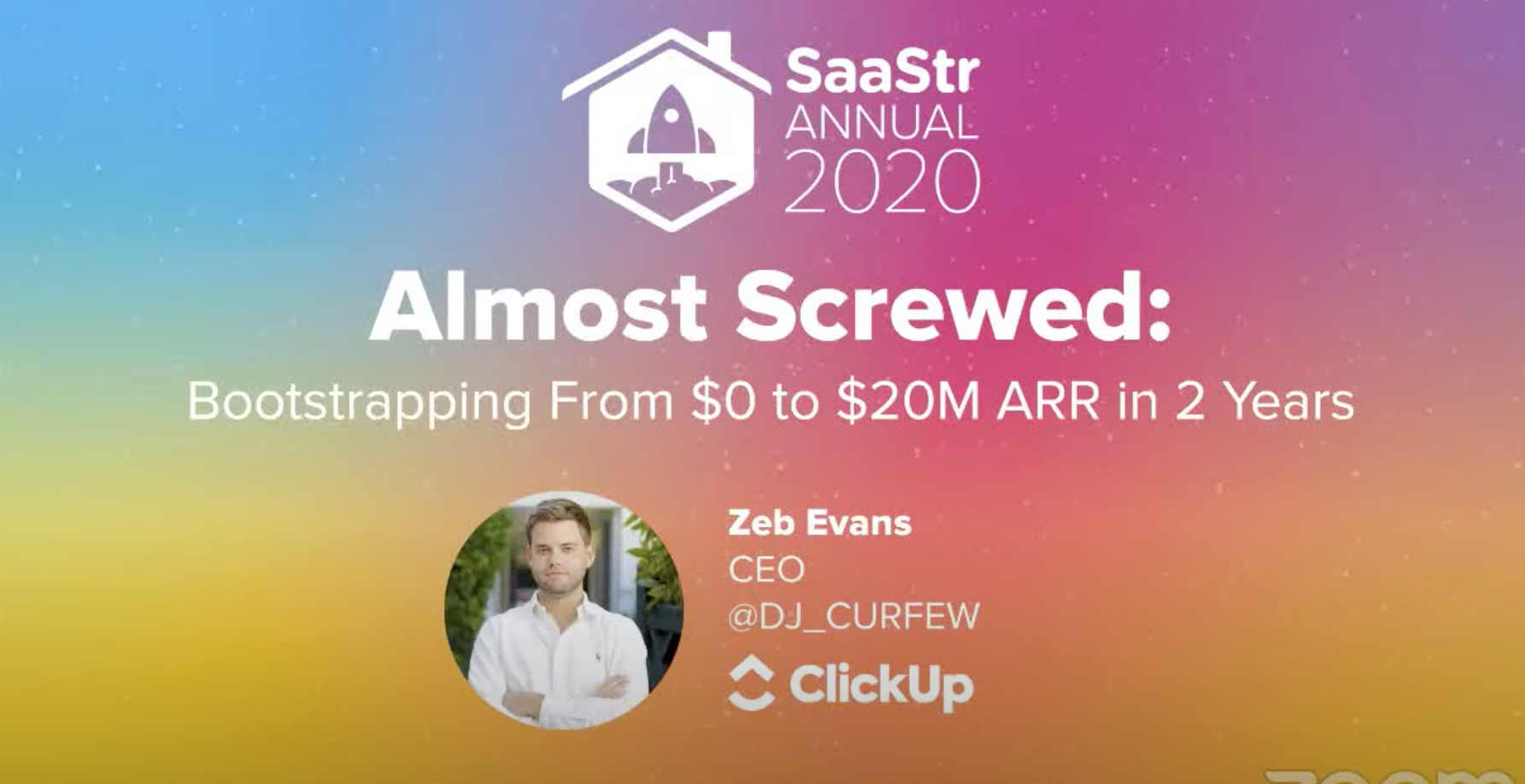Article's Content
For a company created in 2017, ClickUp has enjoyed remarkable success in the project management space — one of the most competitive software markets in the world.
Let’s look at the numbers.
- Over 4 million users
- 85K paying customers
- $4B valuation for a private company
- $20M ARR within two years while bootstrapped
Here’s what ClickUp’s growth scorecard currently looks like.
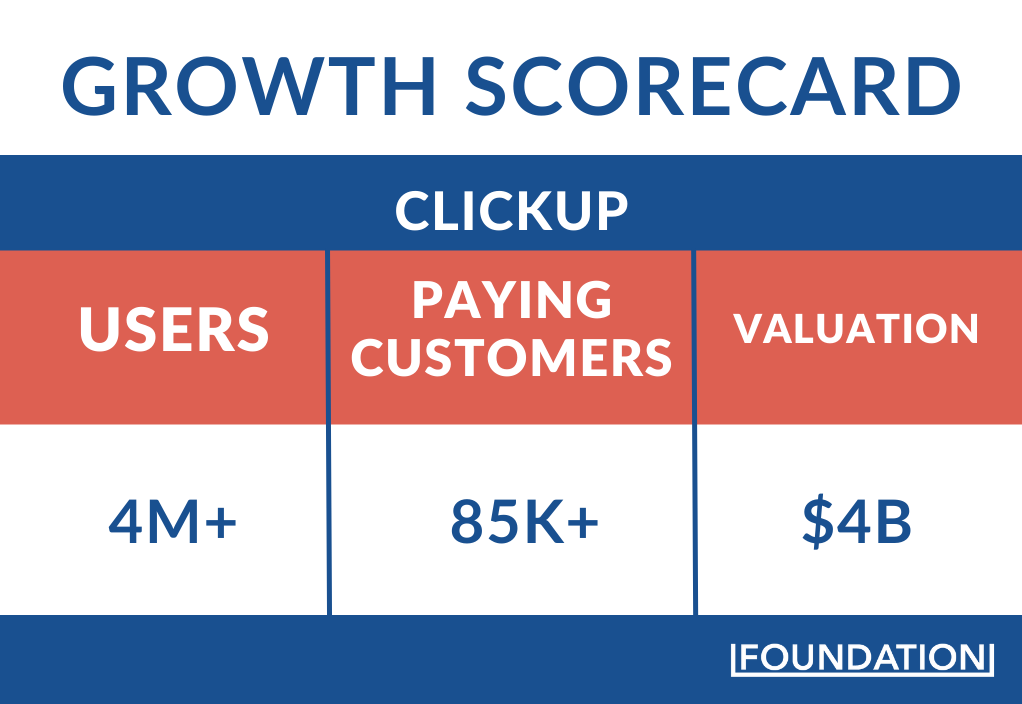
You might begin to wonder, how did ClickUp manage to achieve all of this while competing with project management household names like Asana, monday.com, and Trello?
This analysis aims to share some of the key factors and strategies that allow ClickUp to continue to thrive in the project management red ocean.
By the end of this analysis, you’ll have learned how ClickUp:
- Achieves natural product fit
- Executes a product-lead content strategy
- Drives brand awareness through social media and videos
- Uses feedback to create a better product
- Handles shipping new features and bug fixes
Let’s begin.
Finding Natural Product-Market Fit
Smart founders know they can’t create a product without testing if a market is willing to pay for that product.
That’d be like setting up a steak house in a vegan city.
Sure, some folks will bite, but it’d definitely not be enough to sustain, never mind generate profit from the business. And that’s why achieving product-market fit is crucial.
In his book The Lean Product Playbook, Dan Olsen outlines a simple 6-step method for achieving product-market fit. Here’s how ClickUp ticks off each step.
1. Determine your target customer
The first step to achieving product-market fit is to find out who you want to serve with your product.
ClickUp seems to have found its ideal target customer early on, considering that the tool was created in the first place to help the founder’s team internally manage their responsibilities and projects.
So ClickUp’s target customer was really anyone who wanted to be more productive or efficient at managing their project — literally anyone.
2. Identify customer needs that current products don’t satisfy
After identifying your target customer, the next step is to uncover the unmet or unsatisfied needs of said customer.
In 2017, the project management space was already overflowing with tools, but most of them did only one thing really well, making people have to use different tools for their needs.
ClickUp was created to eliminate the pain of managing different tools and save even more time.
3. Define your value proposition
How do you make your audience see that you offer a new solution in the market? First, create and define your value proposition.
Your value proposition is expected to set you apart from your competitors and highlight your product’s benefits.
For ClickUp, their value proposition was simple — one app to replace them all and help you save one day every week. Simple, yet efficient.
4. Specify your minimum viable product (MVP) feature set
A minimum viable product (MVP) is the barest or most basic version of a new product used to test the market and gain the attention of potential customers.
The idea at this stage is to collect enough feedback from your target audience to understand your product’s strengths and weaknesses to improve it or double down on what works.
ClickUp’s MVP feature set included but was not limited to:
- Collaboration detection
- Setting priority for tasks
- Ability to assign and resolve comments
- Organizing tasks through a board, list, or box view
- Super rich editing
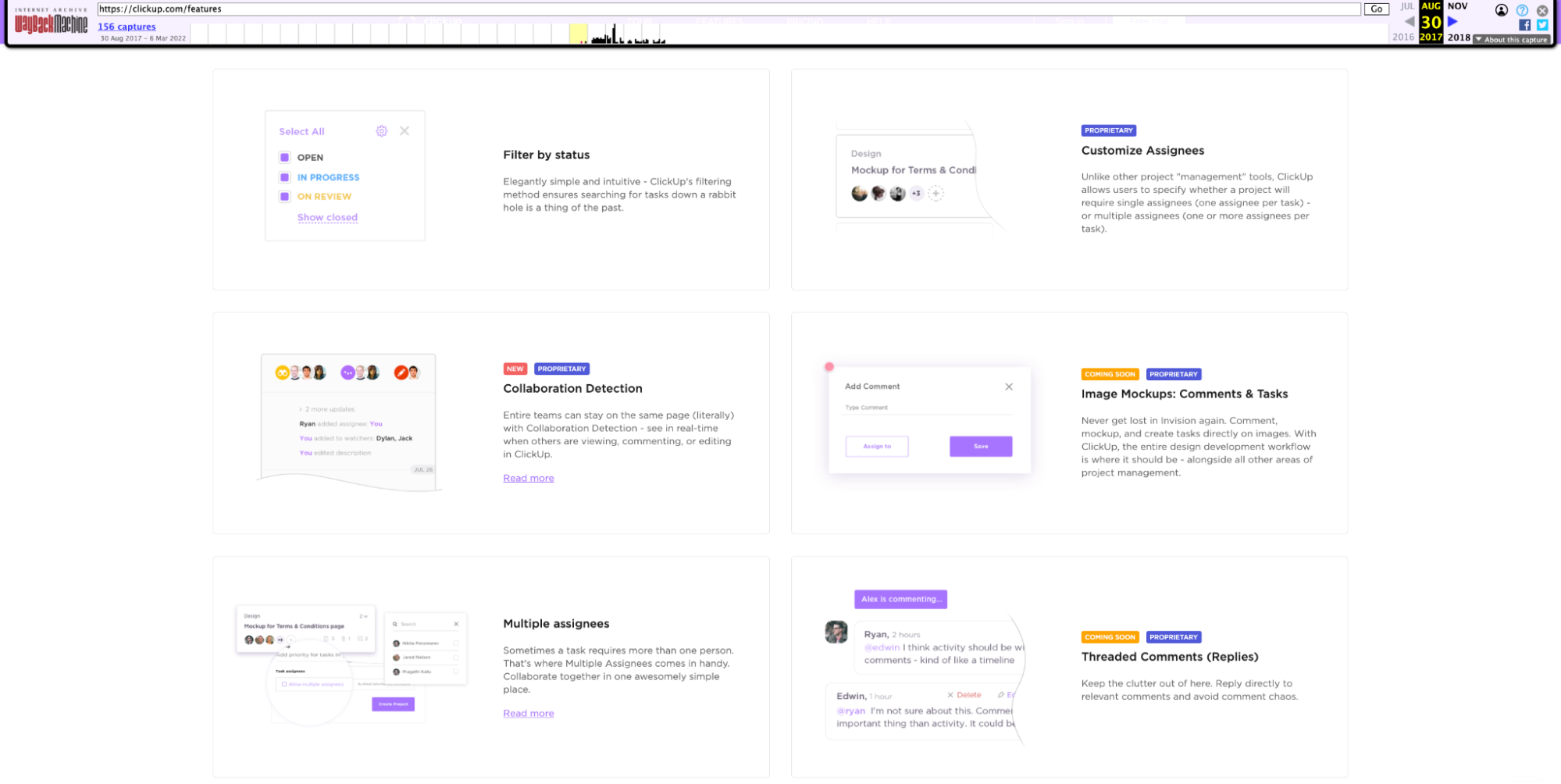
Many of these features were undoubtedly unique compared to what the other project management tools offered.
5. Develop your MVP prototype
Once you’ve decided on your MVP’s feature set, it’s now time to create a prototype.
The prototype helps you picture how you expect people to use the features you just created. And it is primarily used to access design flaws in your product’s usability.
It is also what brings the MVP feature set to life and presents a way for people to test your product.
ClickUp initially used a web app for the prototype before creating a mobile app shortly after.
6. Test your MVP with customers
The final step to achieving product-market fit is to test your MVP with real customers. These customers typically leave feedback concerning the user experience, messaging, and functionality of the tool.
Zeb Evans talks more about ClickUp’s story of achieving product-market fit in this interview.
But how did ClickUp find its first customers to help complete the final step to achieving a natural product-market fit?
The answer: Through organic content and word of mouth.
Let’s now consider how ClickUp attracted its first customers through content.
How ClickUp Attracts Users Through Long-tail Keywords
Every month, over 767K people find ClickUp through organic search.
For comparison, that’s like having 2X of Iceland’s entire population visiting ClickUp’s website every month — that’s a pretty big deal.
Here’s ClickUp’s search scorecard to help you get a bigger picture of how massive their website is.

Of the over 297K keywords ClickUp ranks for, a significant percentage comes from specific long-tail terms people are looking for. And these long-tail keywords usually get thousands of searches every month.
For instance, ClickUp ranks in the number one spot for the keyword task management software, which gets over 2,000 monthly searches.
Since it’s the number one result, ClickUp generates over 1.7K visits per month for this term alone and over 20K monthly visits for the entire article.
This example isn’t a unicorn in the mix, as ClickUp has other articles that target and rank for long-tail keywords like:
- Free management software
- Free Gantt chart
- Project management tools
- How to create a timesheet in Excel
- Agile project management certification
And many others closely related to project management.
Aside from its articles, ClickUp also uses dedicated landing pages and templates to help its target audience understand the product’s functionality and eventually fall in love with it.
ClickUp’s dedicated landing pages or use cases pages contain over 30 different landing pages for different types of potential customers — like students, marketing teams, real estate agents, and non-profit managers — who might be interested in using ClickUp for managing their projects.
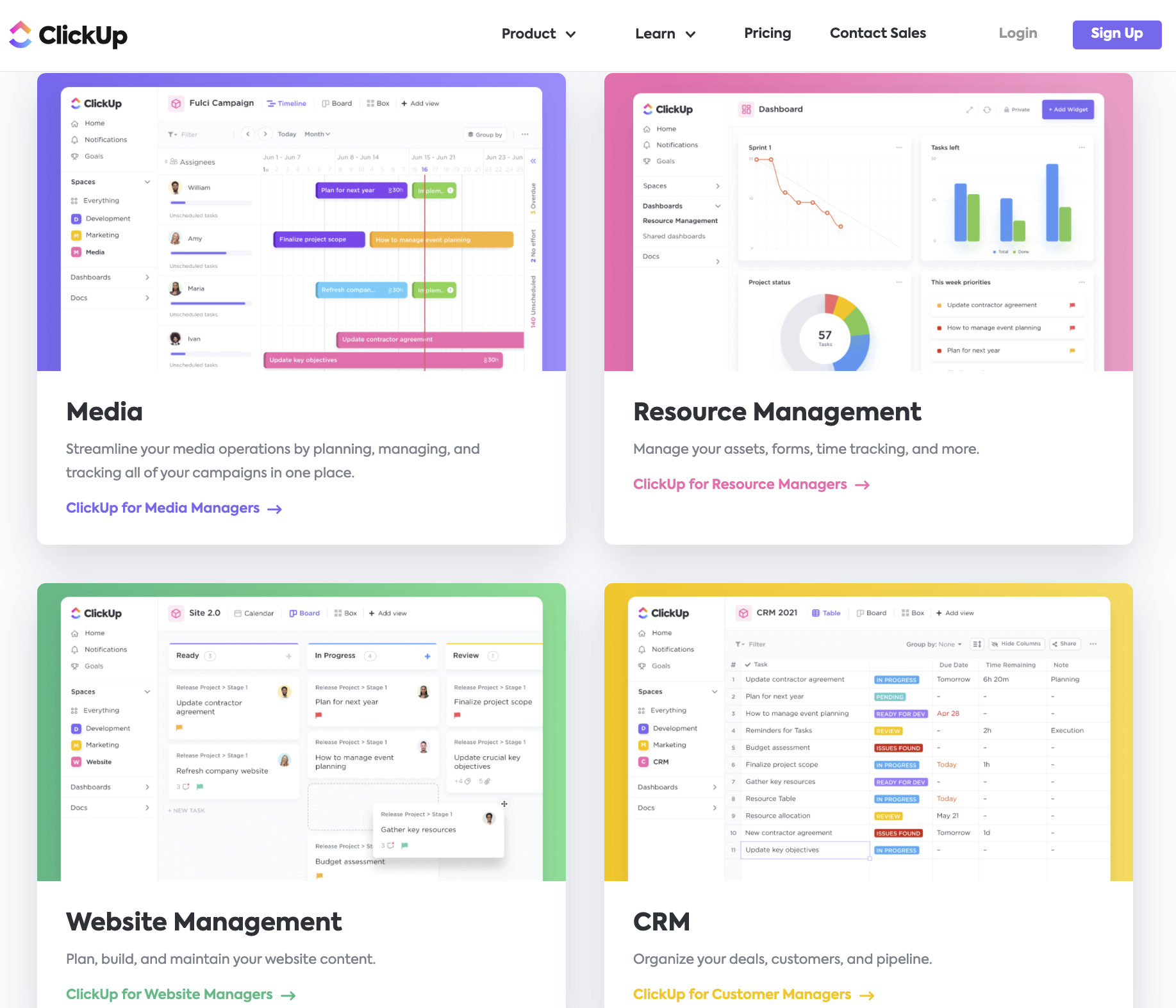
Templates make it easy for people unfamiliar with a tool to get a done-for-you structure they can quickly replicate and start using to increase their productivity. ClickUp understands this, so they have an extensive library of templates people can use for different use cases.
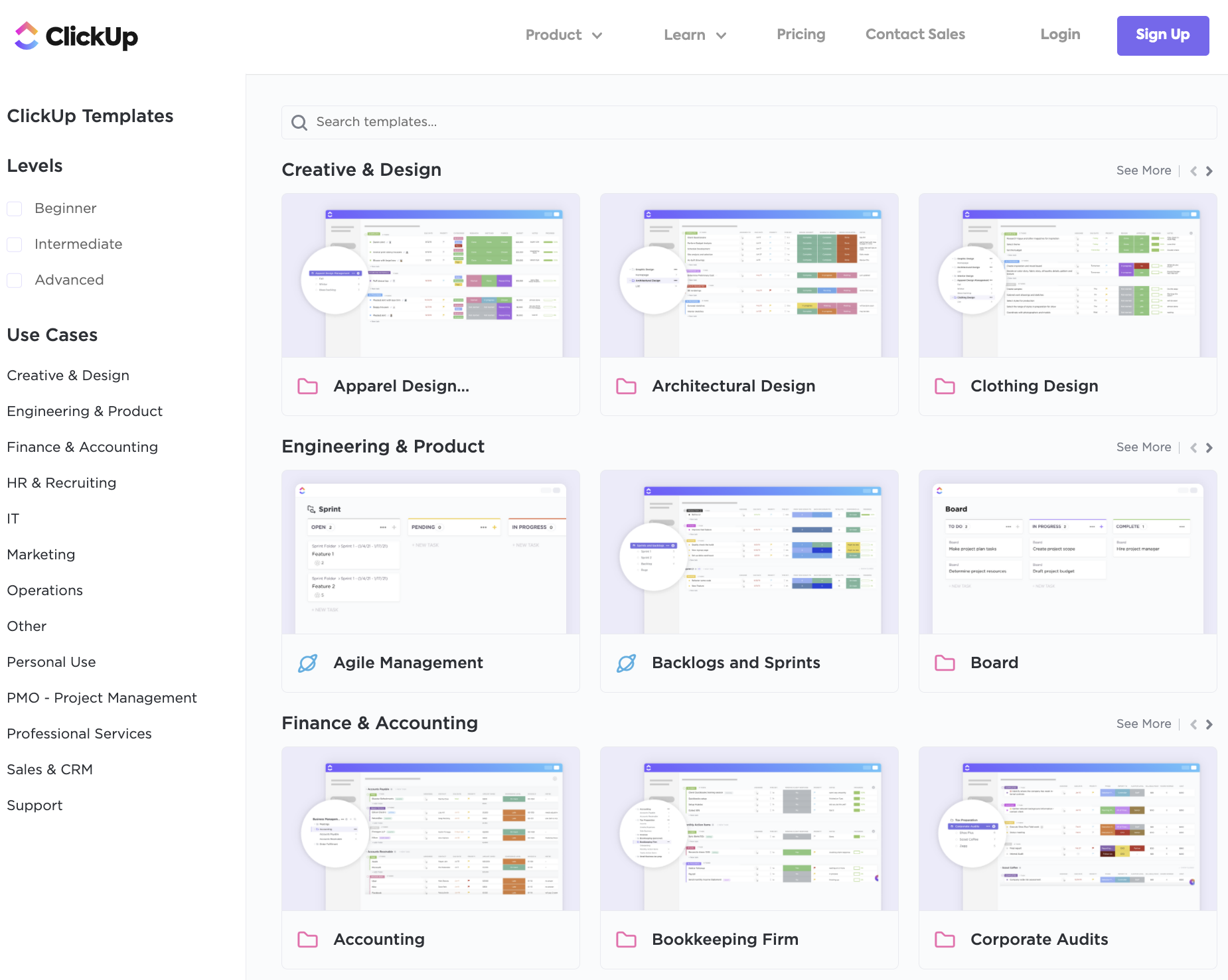
Let’s assume someone who works in marketing comes across this page while looking for a tool to help their team manage projects better. Since the landing page is tailored to their specific needs, they’ll immediately feel like ClickUp is the tool for them. That’s the power use-case-driven content holds.
Although the template page and landing pages aren’t performing so well in terms of organic traffic (yet), they still target long-tail keywords that ClickUp knows its audience would be searching online. And it’s only a matter of time before they start attracting a lot more potential users.
Solving Audience Problems Through Product-led Content
Product-led content isn’t just another buzzword that founders and marketers throw around to make themselves sound smart. On the contrary, it’s a proven method to create content that quickly differentiates you from the competition and highlights your unique value to existing and potential customers.
If you’re not already familiar with the term, product-led content is any piece of content created to address the pain points of an audience while showing how a product (typically your product) solves the audience’s problems.
Considering that ClickUp was coming relatively late to the project management party, they had to do more than just educate their audience with helpful information — something their competitors were already doing. They had to create content that weaves in its product’s features so excellently to turn curious readers into users.
For this analysis, we’ll use ClickUp’s article about examples of professional goals for work.
This article alone drives almost 20K monthly visits to the ClickUp website and would cost around $21.4k in pay-per-click ads to attract the amount of traffic it does organically.
Here’s what the search scorecard for this article looks like.
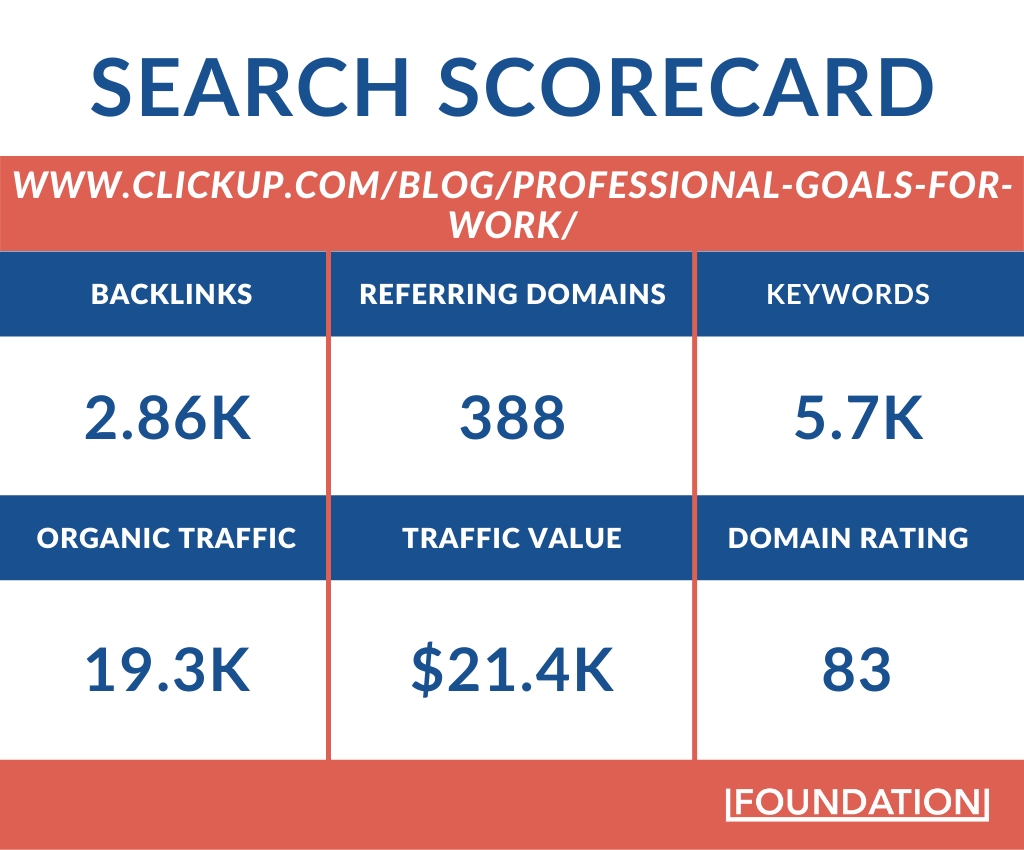
Like most of the articles on ClickUp’s blog, this “work goals” article shows how readers can overcome their challenges using ClickUp.
The article’s ideal reader faces a challenge — they’re unsure about the type of goal to create to improve their professional life and personal development.
Enter: ClickUp.
Throughout the article, ClickUp shares practical ways readers can use the tool’s different features to set goals and manage and hold themselves accountable.
Here’s one instance of a mention of ClickUp’s Agile-Scrum Workflow.
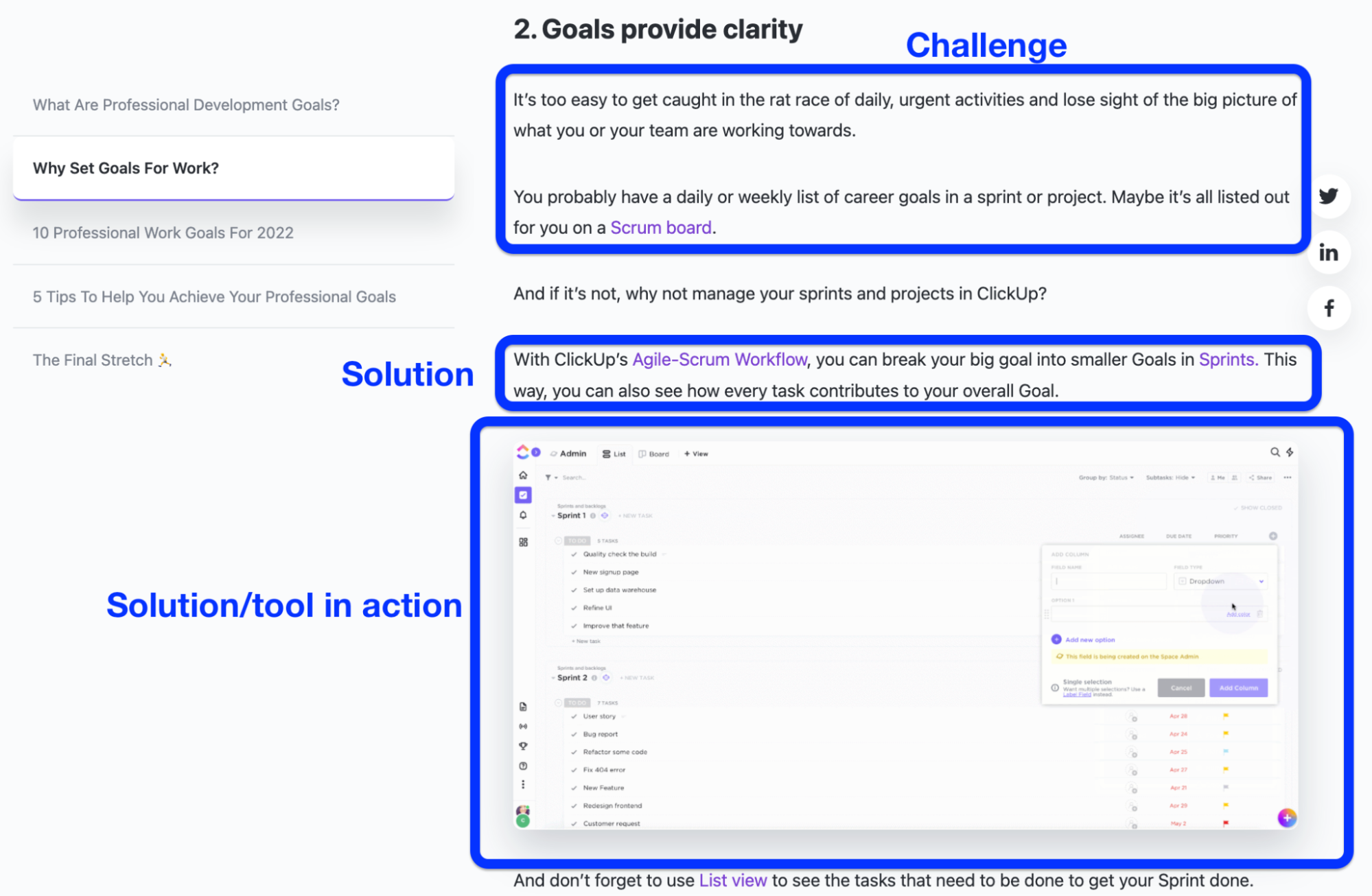
Here’s another instance where the article highlights ClickUp’s collaborative features.
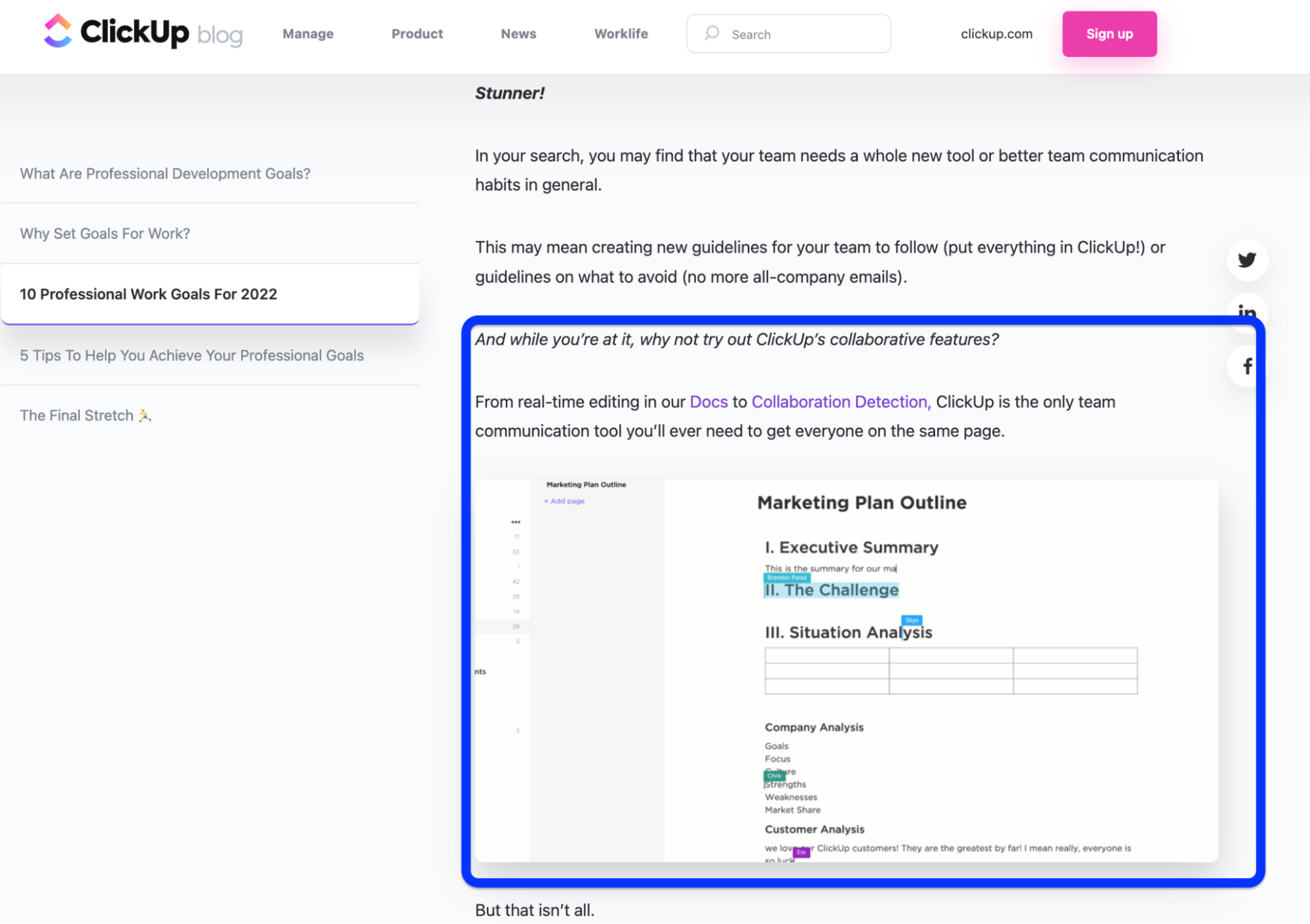
And still another instance of showing readers — with screenshots — ClickUp’s time management features.
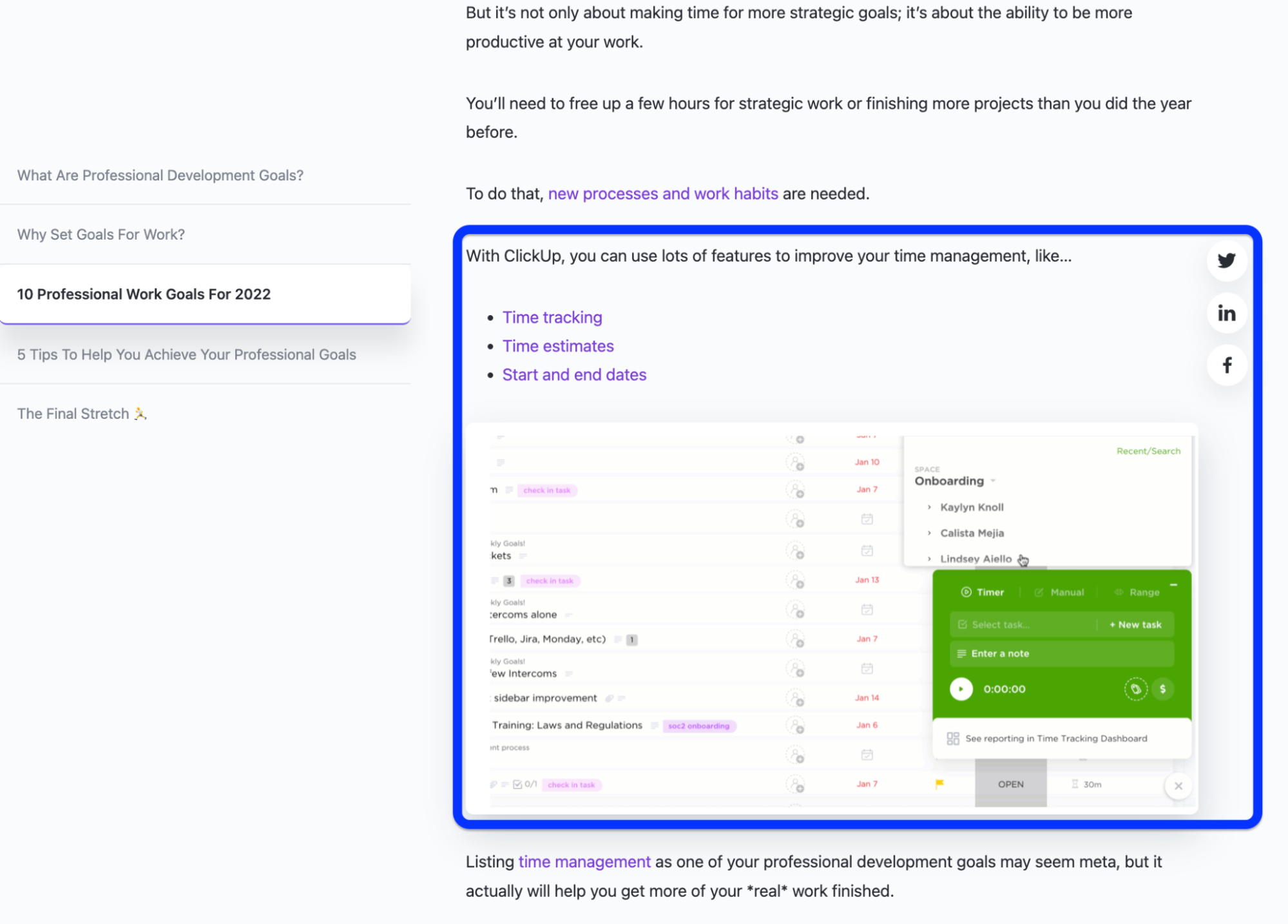
There are still about 3-4 more instances in this article where ClickUp references their tool and its features, showing readers that they can find all they’re looking for inside ClickUp.
However, even with product-led content, ClickUp does well not to unnecessarily insert their product features in areas where they don’t offer a solution to their audience’s problems.
While product-led content aims to maximize the chances of conversion, anyone who reads ClickUp’s articles would still find it valuable even if they don’t sign up for the tool.
Away from blog content, ClickUp also uses comparison pages to compete and grow in their market.
Let’s find out how.
Building Competitor Comparison Pages
We’ve already established that ClickUp is in a tough industry with many competitors fighting for some share in the same market.
If you’re still doubting, I’d like you to simply type “ClickUp versus” or “ClickUp or” into your search bar to see the autocomplete suggestions Google brings on.
Here’s what mine looks like:

People want to know how ClickUp and other project management tools compare to each other.
It’s evident that the people performing these searches are way past the awareness stage of their buyers’ journey. Instead, they’re at the consideration or decision stage, and that’s why they’re searching with a commercial or investigation intent.
To match their audience’s search intent, ClickUp created comparison pages.
They created one that gives a general overview of how ClickUp compares to all the other project management and productivity tools. This one lives on the clickup.com/compare domain.
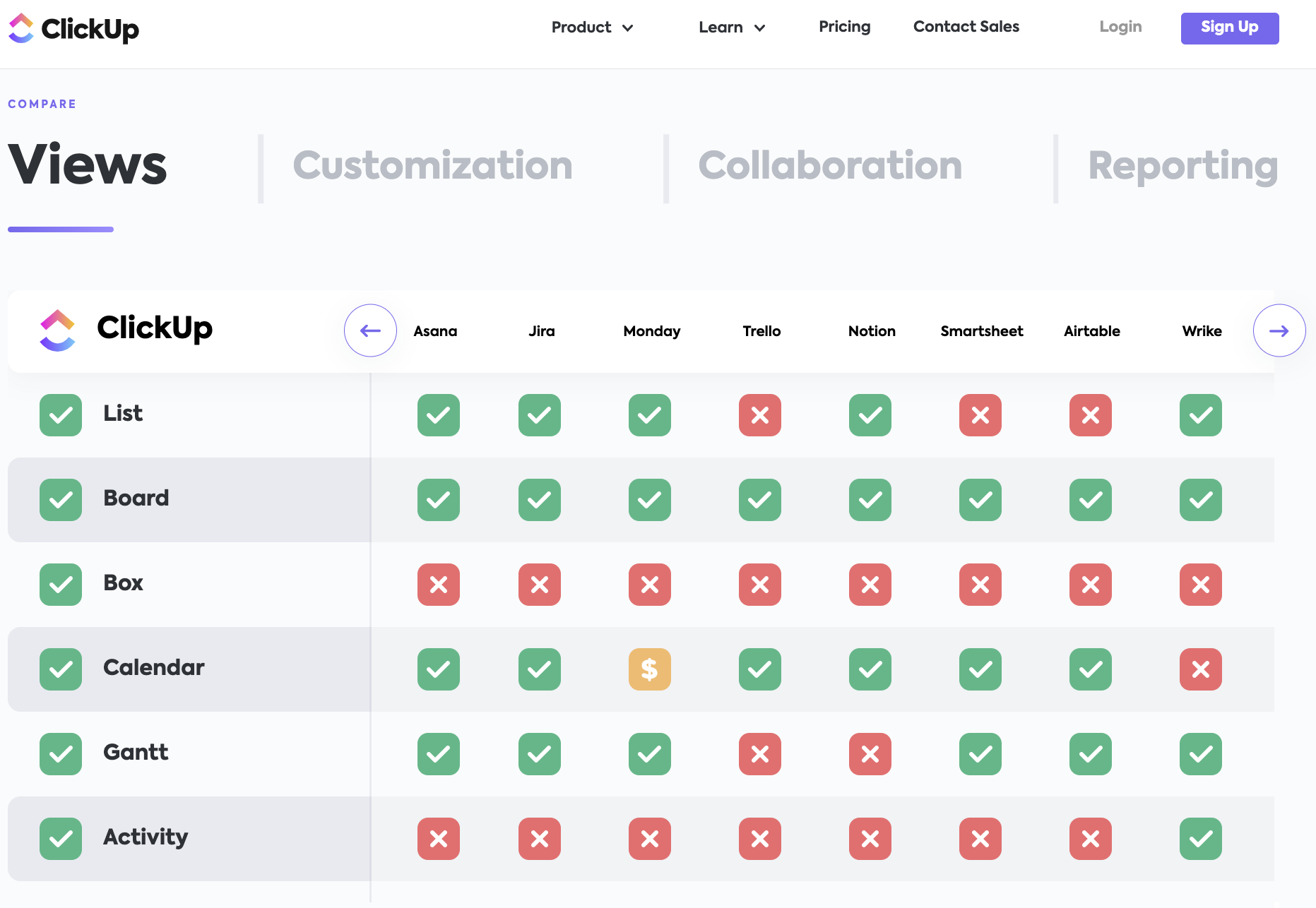
And then sub-pages dedicated to the specific differences between ClickUp and other tools.
For instance, here’s the page comparing ClickUp and monday.com.
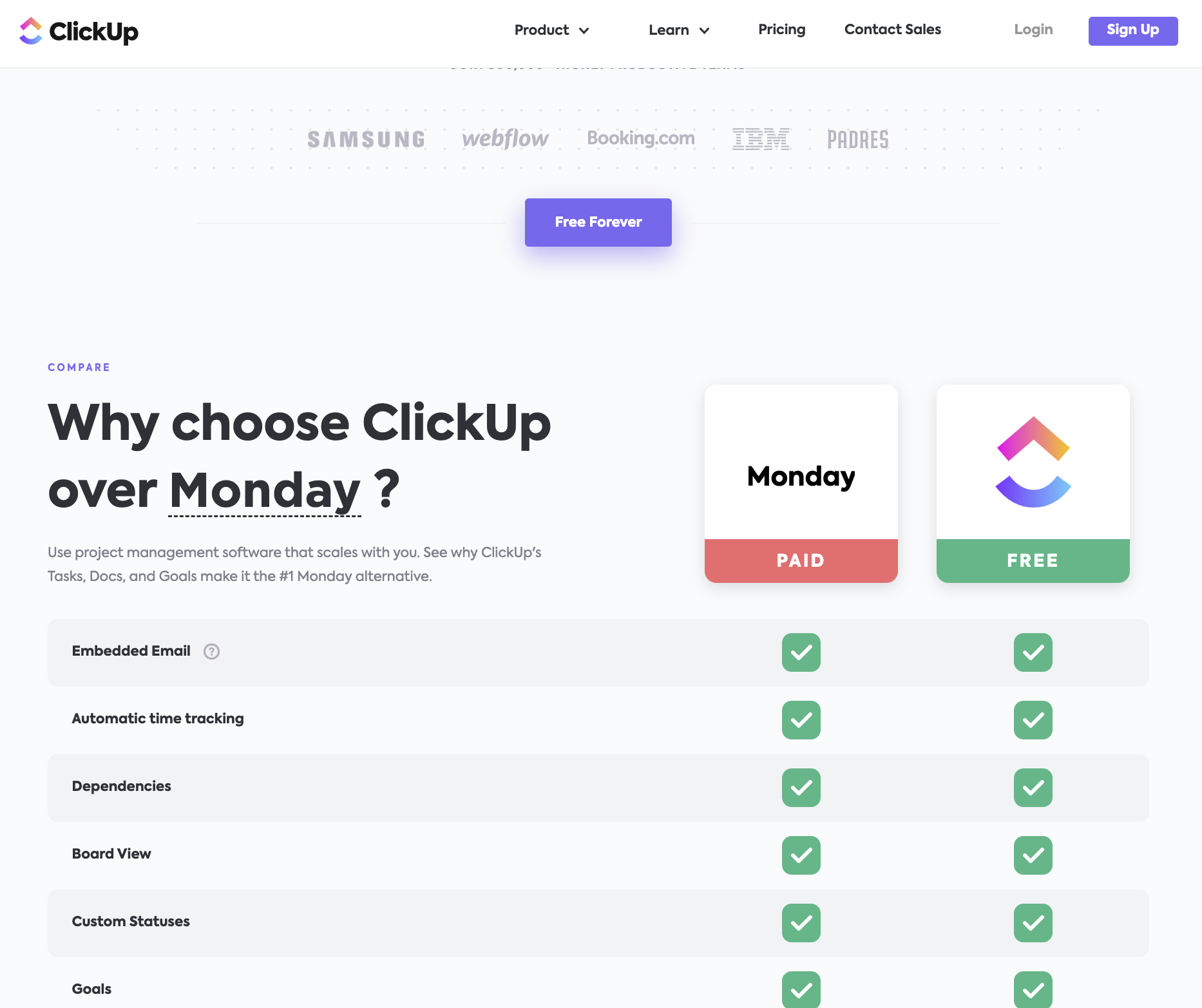
Like most comparison pages, ClickUp starts by giving monday.com a few green ticks, but as you scroll, you’ll see monday.com getting more red crosses, which then paints ClickUp more positively.
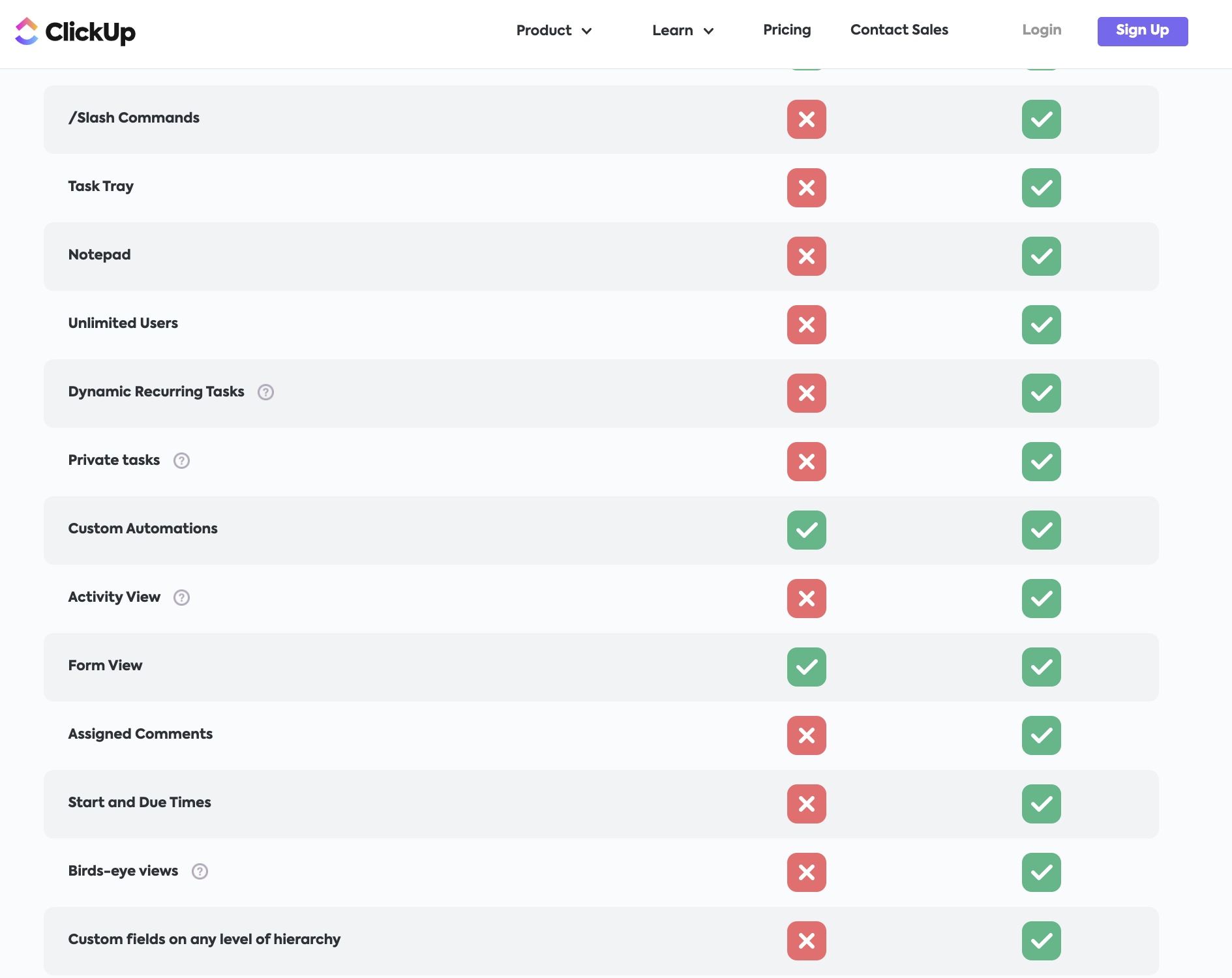
If you scroll even farther down the comparison page, you’ll see ClickUp mention other things they do better than monday.com, like having more integrations and better views.
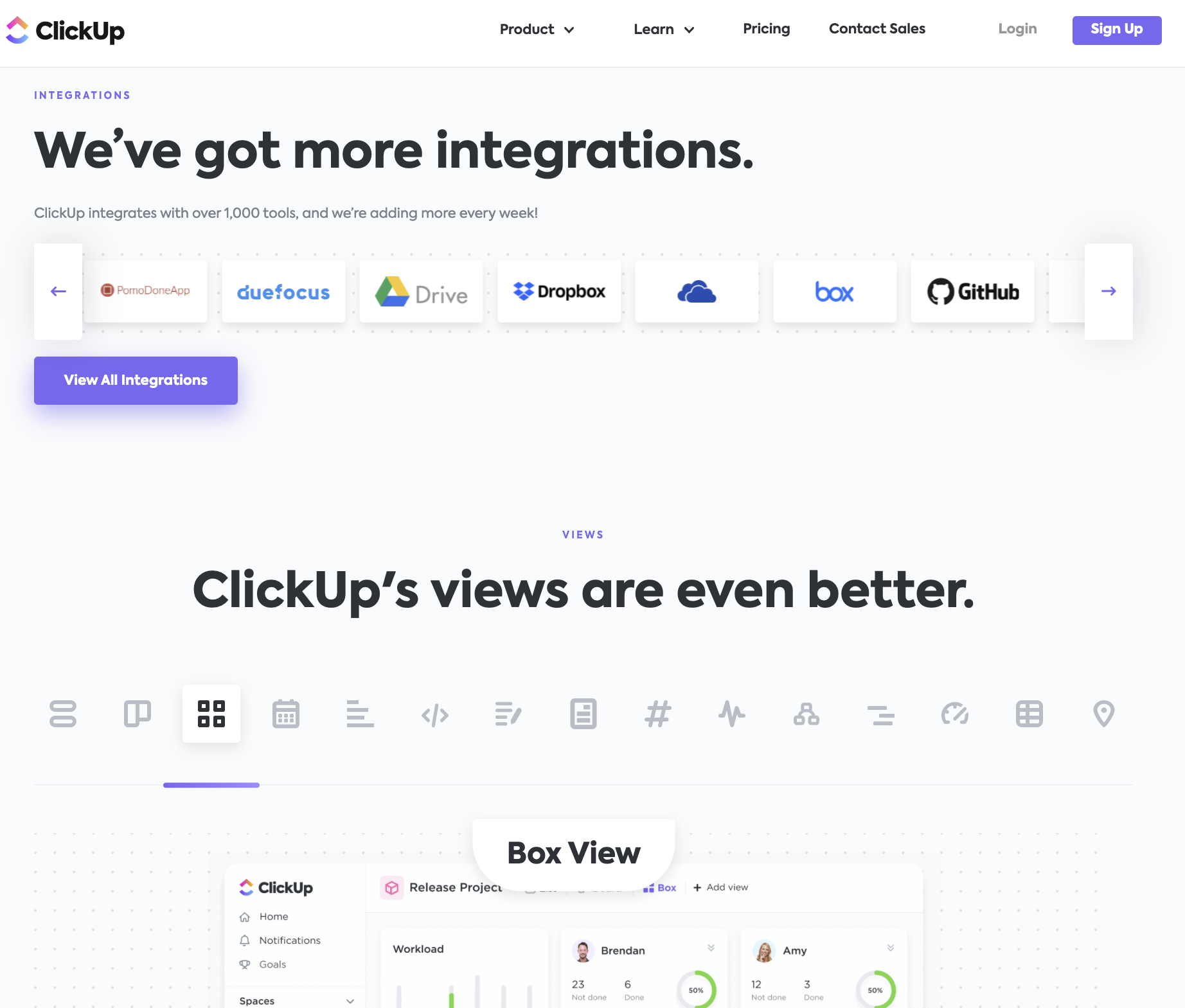
By producing these kinds of comparison pages, ClickUp has been able to rank for keywords like:
- ClickUp vs. Airtable
- Asana vs. ClickUp
- ClickUp vs. Monday
- ClickUp vs. Notion
- Plutio alternative
And so many comparison-related others, all of which translate to over 2K monthly visits.
Here’s a chart to show how much traffic and keywords ClickUp’s comparison pages attract when compared to its competitors.
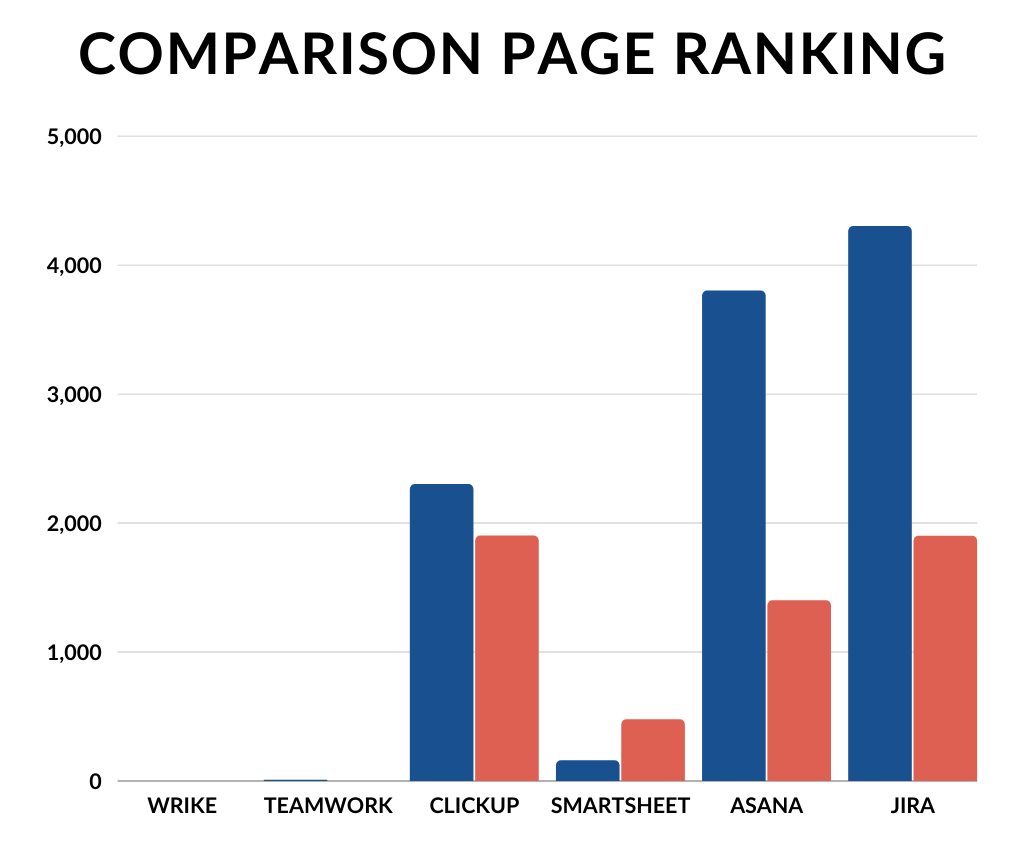
Atlassian’s Jira and Asana seem to have created an SEO moat that currently helps them lead other sites regarding comparison pages. However, ClickUp isn’t too far behind.
To complement the organic traffic these comparison pages pull, ClickUp also runs Google ads that show up when people are looking for project management tools.
For example, ClickUp has an ad running for the term “ClickUp or Asana.” When anyone searches this term on Google, this ad shows up:

It’s estimated that ClickUp spends over $400K monthly on PPC ads targeting keywords like Trello, Asana vs. Monday, Gantt Chart, Google Workspace, and more.
But these aren’t the only types of ads they run to attract customers.
Driving Growth Through Paid Efforts and Social Media
Now that ClickUp had achieved a natural product-market fit thanks to its organic users, it was only a matter of time before they started advertising the living daylights out of their tool. After all, they’re in a competitive landscape.
Aside from the search engine ads we just covered, ClickUp also uses social media to reach a wider audience.
I wouldn’t be surprised if you say you’ve seen their ads pop up on your social media feed, whether on Facebook, Twitter, or LinkedIn.
If you haven’t come across any of their ads, you can check some of them on their Facebook Ads Library.
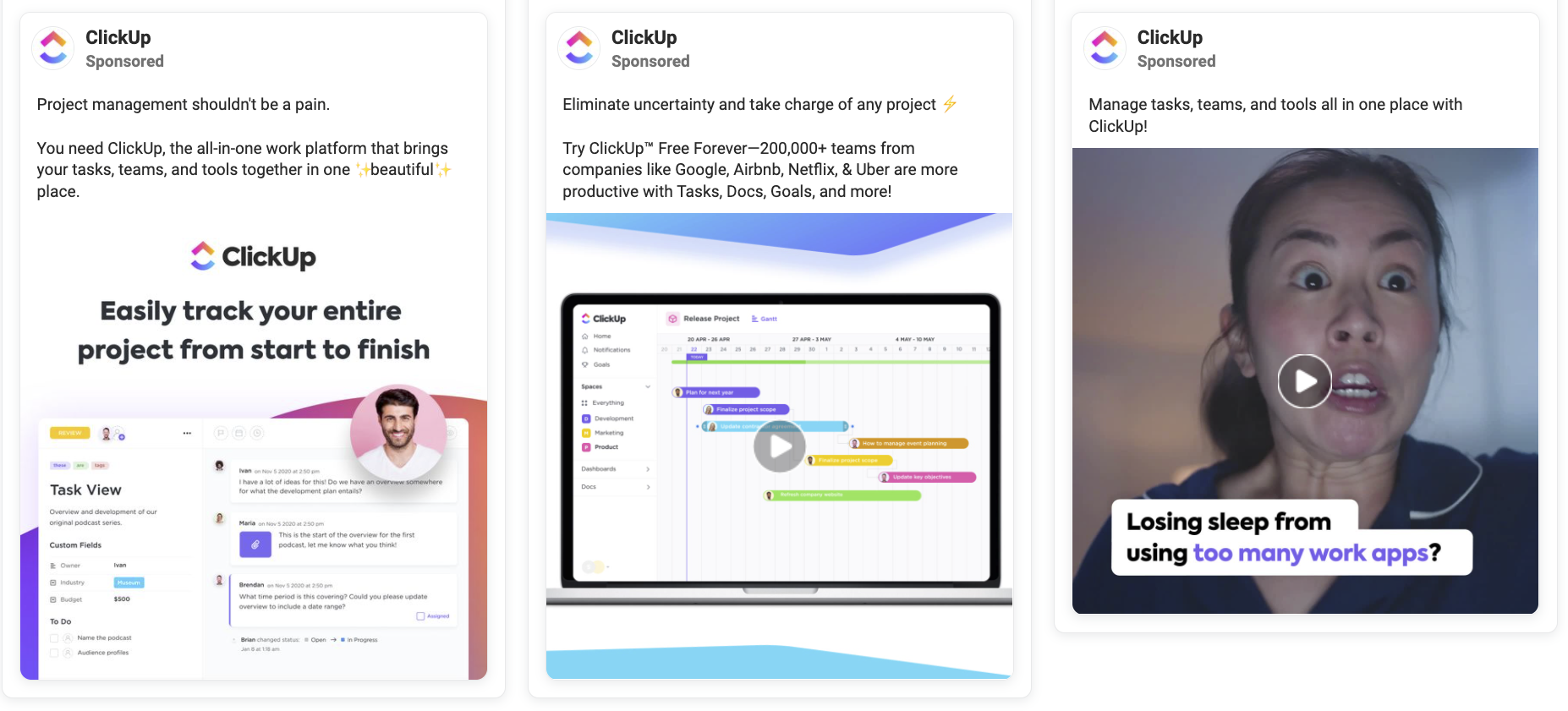
To show how big ClickUp currently is on ads, they even created one for the Superbowl. You can watch it here.
https://www.youtube.com/watch?v=AirnL1NxOAw&feature=youtu.be
Unlike most B2B brands, ClickUp’s ads don’t usually look like ads, as they’re more engaging.
Don’t take my word for it. Here’s a real-life post from a ClickUp user in a ClickUp subreddit.

And that brings me to another excellent method ClickUp uses to drive growth — through organic social media.
Let’s use their Instagram pages as a case study.
It’s a rare sight to see B2B companies thrive on Instagram. However, with most of their posts having upwards of 400 likes and a dozen comments, I dare say that ClickUp is killing it.
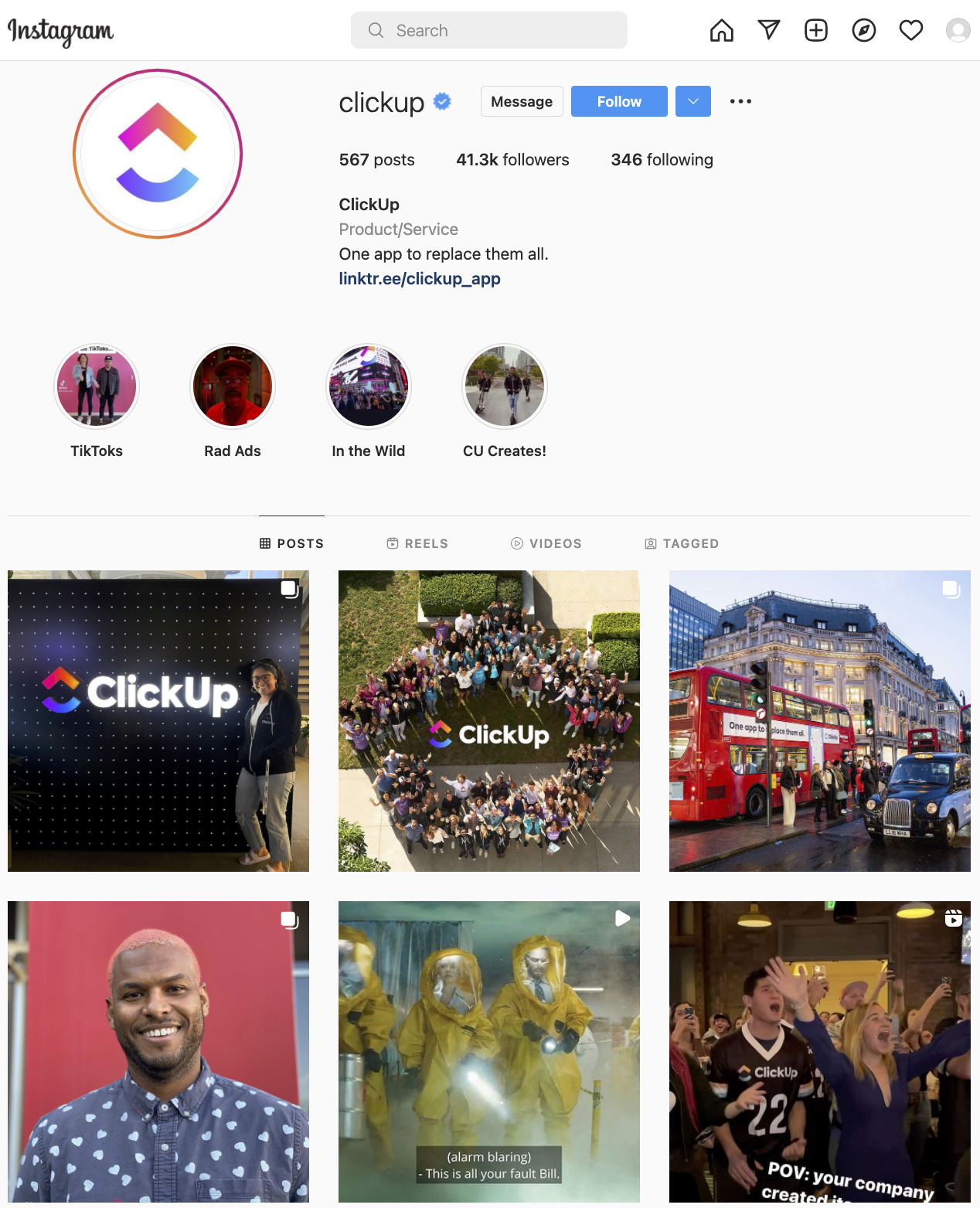
Here are a couple of things that make their Instagram profile stand out:
- They create behind-the-scenes content around how business is done at ClickUp. This, in a way, helps the company become more relatable to its audience.
- They show off their employees. Doing so helps people see ClickUp as a company that values its employees and helps them take a peek at the company’s culture.
- They share inspirational content. People love to be inspired, and who better to inspire people than a company that makes productivity tools?
- They post entertaining videos. Many already consider B2B companies boring. So it’s a breath of fresh air to see ClickUp create fun videos people find amusing.
Another social media platform where ClickUp thrives is YouTube, where they have over 55K subscribers.
Being on YouTube is excellent for helping ClickUp reach people still at the awareness stage of their buyers’ journey. Aside from using YouTube to house their ads, ClickUp also creates branded YouTube videos to help anyone get started using the tool.
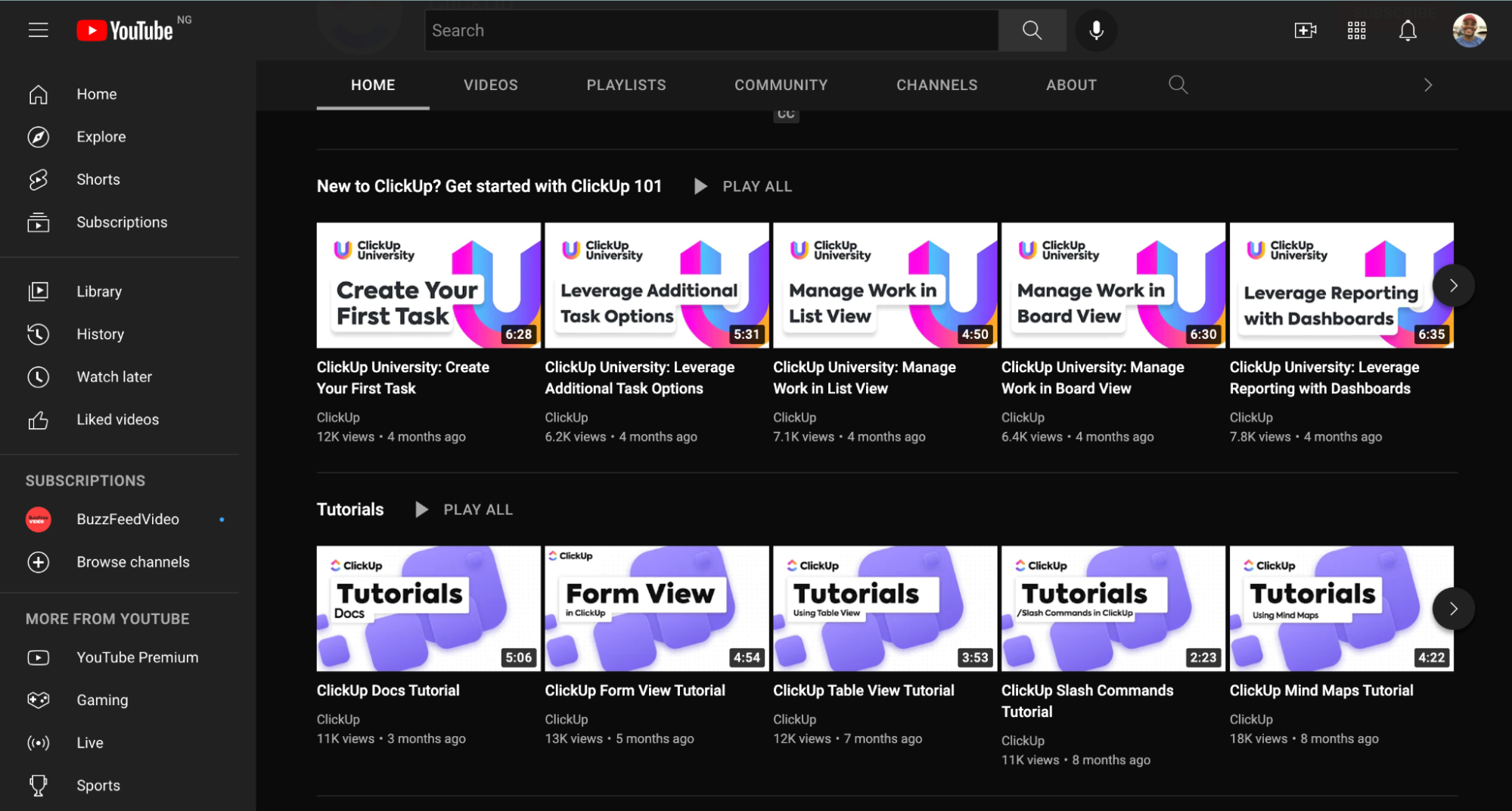
These informative videos are usually short as they answer specific queries searchers might have.
Although ClickUp’s videos are great, they could be doing better.
One specific area where they could improve is in their choice of thumbnails.
Marketing experts recommend including peoples’ faces as it can improve click-through rates. However, that doesn’t mean the images would lose ClickUp’s branding. Instead, it would make the videos appear more welcoming and human.
Now that ClickUp has found ways to attract users consistently, what next?
Using Feedback to Better Your Products
There’s an African proverb that, when loosely translated, says:
“Ears that do not listen to advice accompany the head when it is chopped off.”
To not have their heads “chopped off” by the competition, ClickUp goes to tremendous lengths to listen to their users — after all, they’re the ones who can tell if the tool is serving its purpose.
The ClickUp team collects feedback with Canny, a customer feedback management tool. The way the tool is set up, users can quickly leave feedback without leaving ClickUp.
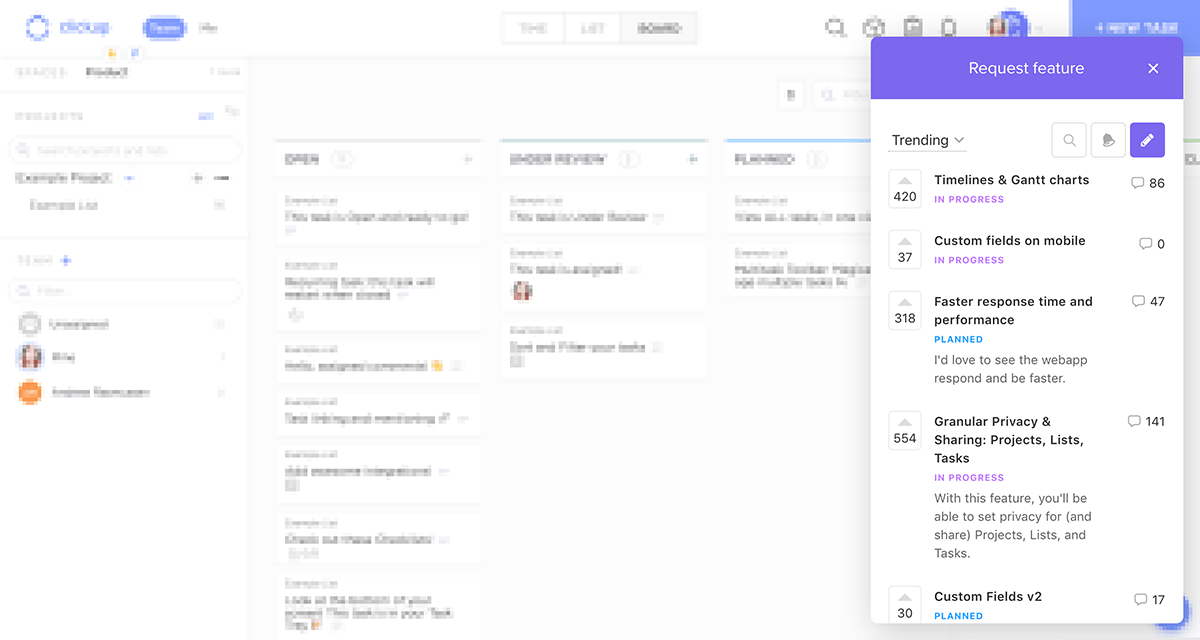
Once they receive feedback, the ClickUp team gets to work to address the issues users raise concerning the tool. This has helped them improve the user experience, the onboarding process, and upgrade existing features.
Aside from using Canny, ClickUp also developed real connections with their users by hopping on Zoom calls and having in-person meetings (pre-COVID) with their users.
As they build trust with their users by listening to them and implementing their suggestions, ClickUp was able to create a viral loop that helped their tool spread through word of mouth.
First-Movers Advantage and Why You Should Ship as Fast as Possible
ClickUp undoubtedly had some ground to cover considering when they entered the market, and they covered said ground by shipping new features and fixing bugs as fast as possible.
In fact, for more than two years now, ClickUp has shipped a new product release every Friday. As expected, these launches are not always perfect, but as Zeb puts it, “what matters most is progress over perfection.”
Final Thoughts
For ClickUp, the product-market fit was what mattered the most. Achieving this first allowed them to knock every other thing they did out of the park.
And it’s safe to say that their method works, considering how far they’ve come in a really tough space.
While $20M ARR in two years might be a lofty goal to achieve, it’s absolutely possible, as ClickUp’s example has shown.
To put yourself well on your way to achieving such goals, here’s what you should do:
- Find a natural product-market fit first
- Attract your first users through organic product-led content
- Listen to feedback from these users to improve your product
- Ship new features as fast as possible
And you too will start to see results for your business in no time.
Want to learn more about B2B strategies to transform your business? Download our free B2B growth strategies guide today.







